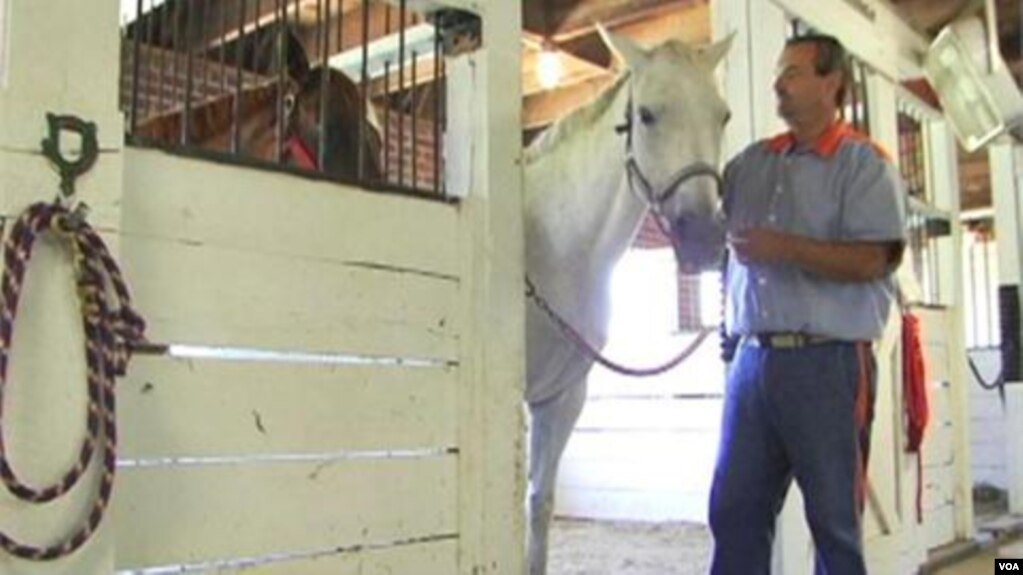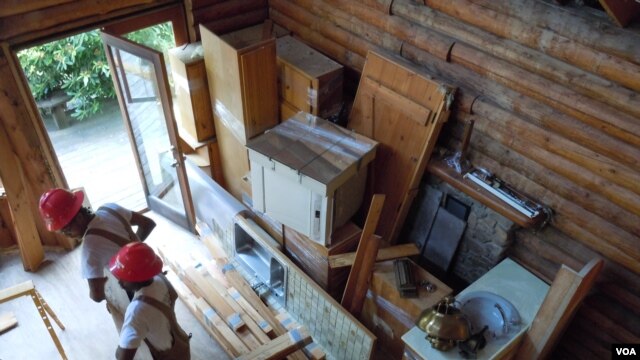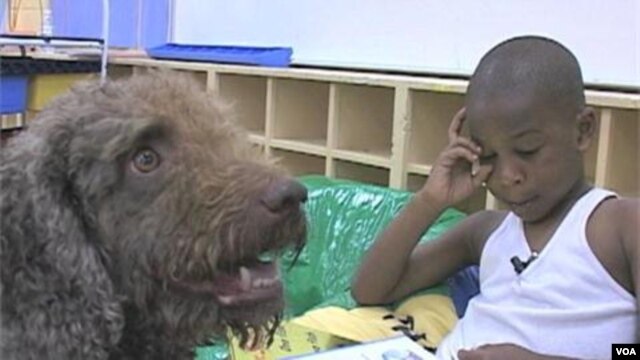
CAROLYN PRESUTTI: Welcome to THIS IS AMERICA in VOA Special English. I’m Carloyn Presutti.
STEVE EMBER: And I’m Steve Ember. This week on our show, we tell you about a program that gives prisoners and retired racehorses a second chance at life. Then, we learn about an organization called Second Chance. It gives men with troubled pasts a way to learn new job skills by taking buildings apart to reuse the materials. And, later, we visit a school where dogs are helping children learn to read.
(MUSIC)
CAROLYN PRESUTTI: Many prisons have programs to help prisoners develop job skills. But a program at the James River Work Center, a prison in the state of Virginia, is a little unusual. It teaches inmates to care for retired racehorses. The horses are retrained for new lives, while the inmates learn job skills for their life after release.
STEVE EMBER: The Thoroughbred Retirement Foundation is a nonprofit group that works with the prison. The group tries to save former racehorses from the possibility of being mistreated or being sent to a slaughterhouse after they are retired.
Prisoners like this man enjoy working with the animals.
INMATE: “When they asked me if I was interested in this program, I jumped on the opportunity, because how could you not love these creatures?”
During the six-month program, the men learn all about horses -- their behavior, their health and how to care for them.
ELLIOT (INMATE): “This is my horse Covert Action. This is the grandson of Secretariat. He's a good horse. If you remember Secretariat, that's the horse that won the race in the Belmont.”
RYAN (INMATE): “I think he had a typical racetrack life. He showed signs of steroid injections, side effects of that is biting, nipping, you can feel scar tissue from the injections.”
CAROLYN PRESUTTI: The horses are fed twice a day. The prisoners also groom the animals and check for injuries or health problems. Some of the horses are ridden to prepare them for adoption. People adopt them for riding or as companion horses for other horses; horses don't like to be alone.
The training program for the inmates includes classroom work. But instructor Reid McLellan says the hands-on experience is the important thing. He says the prisoners learn from the horses that they have to be nice to the animals and not act aggressively.
REID McLELLAN: “It's that spending every day in the stall with those horses, and horses don't put up with the kind of false bravado. They recognize false bravado right away. And they'll teach them a lesson that that's not the way to be in harmony with this big one thousand pound animal in that stall.”
STEVE EMBER: Will is a graduate of the program, and is now a teaching assistant. His prison term ends in September and he already has a job waiting for him. His horse, Happy, is also starting a new life. Happy used to be difficult to handle but has now been adopted.
WILL (INMATE): "Happy was the first horse I'd been around. She suffered an injury in the field. She was a, needless to say, a cantankerous thing. I guess something changed in her. She's very likable now. Loves attention.”
Happy was not the only one who changed. Ann Tucker of the Thoroughbred Retirement Foundation says Will also had some behavior issues at first.
ANN TUCKER: “Will came into the program a very insecure young man from a troubled background. He had no idea what he wanted to do. Will is now a confident young man. We have a wonderful job for him and a place to live.”
Inmates who complete the training program rarely return to prison. Like the horse he cared for, Will says the program has given him a second chance in life.
WILL: “I don't ever want to go back to the person that I was, or come back to here."
(MUSIC)
CAROLYN PRESUTTI: A different kind of program in Baltimore, Maryland, also gives people with troubled pasts a second chance in life.
(SOUND)
A crew is removing all of the usable material from a house that is going to be torn down. Jim Russell is the project manager for Second Chance, a nonprofit company in Baltimore that does this special kind of work.
JIM RUSSELL: “Right now what we’re doing is extracting the flooring, removing the interior doors and frames and the kitchen cabinets.”
STEVE EMBER: Second Chance hires men from the community and trains them in the art of deconstruction.
JIM RUSSELL: “We bring people in and teach them a skill to enable them to learn a little bit about construction; the way a house is built. And if you know how it’s built, you know how to take it down properly, safely.”

Clarence White is one of the workers. He is learning how to safely and skillfully remove the lumber and stone, and take apart the kitchen and bathrooms. He says working at Second Chance has been a life-changing experience.
CLARENCE WHITE: “Beforehand I was selling drugs, doing all the wrong things. I went to prison, I came home and was looking for a job and a lot of jobs weren’t hiring me. Second Chance provided that opportunity. They believed in me and I went from not feeling confident, feeling like I can’t get a job, I cannot do this, I cannot do that, feeling limited, to feeling limitless.”
CAROLYN PRESUTTI: In addition to job training, the company also provides training in life skills.
CLARENCE WHITE: “Now I have a bank account, I’ve moved into my own place. Also, I’m able to provide for my daughter and give her a better life.”
Clarence White looks forward to building on the foundation of his new life.
CLARENCE WHITE: "I can see myself being a happy old man one day. Before I couldn’t see it; now I see it. It’s a good thing. It’s a great thing.”
The workers have a good relationship among themselves. Joshua Watson has been working at Second Chance for nine months.
JOSHUA WATSON: “I love working with all these guys. They’re like brothers. I’m going to get married in a couple of months and all these guys are going to be my groomsmen.”
The men are guaranteed a job with the company once they have completed their sixteen-week training program. Project manager Jim Russell says many of them move on to other opportunities.
JIM RUSSELL: “We’ve got guys who have become apprentice electricians. Some of them have gone on to become truck drivers. Some of them have come to me and asked me for guidance on maybe starting their own home improvement business, and if I can help them out in any way, I try to.”
(SOUND)
STEVE EMBER: On a recent day, the workers were removing materials from a two-story log cabin build in the nineteen eighties. The wood flooring and doors, the kitchen appliances and other items will be taken to the Second Chance warehouse in Baltimore. There, people can buy household items at a big savings on cost. The money from those sales helps pay for the job training program.
MARK FOSTER: “Our guys I think recognize that this may be their best chance at a new life.”
Mark Foster is the founder and president of Second Chance. The organization has trained more than sixty men since it began in two thousand three.
MARK FOSTER: “The training program here is not just about how to pull nails. It’s about how to be a productive member of society, how to get some skill sets that you wouldn’t have had before. Materials are certainly important to us as a society, but the people are really the thing that should drive us the most -- giving those people opportunities that they otherwise wouldn't have.”
(MUSIC)
CAROLYN PRESUTTI: Can children improve their reading skills by reading to dogs? Researchers at the University of California, Davis, reported in twenty-ten that the answer is yes. Just ask Taivion Scott. He began learning to read last year at Stanton Elementary School in Washington. He struggles with new words, but says it helps when a dog is sitting next to him.
TAIVION SCOTT: “Because they’re calm."
Izzy has been coming to the school for a year with Denise Velasquez, a volunteer with PAL. PAL is People Animals Love, a private group in Washington that brings dogs into schools and libraries.
DENISE VELASQUEZ: “I think you feel a little less self-conscious about struggling when you’re reading to a dog, instead of feeling like you’re reading to your classmates or your teacher.”
She helped Taivion with his reading.
DENISE VELASQUEZ: “I pulled Izzy in a little bit, too, so he could feel a little bit closer to her, and then we started to take it one word at a time because a whole book can feel overwhelming, but a single word is something you can tackle.”
STEVE EMBER: Eric Reithel from the PAL program says he can identify with the children because he had problems with reading when he was young.

ERIC REITHEL: “They feel more confident reading to a dog, a dog’s not judgmental, a dog isn’t going to tell them that’s the wrong word."
These children live in the Anacostia neighborhood of Washington, DC.
ERIC REITHEL: “This district has the highest poverty in DC, and this particular neighborhood has the highest crime rate in DC. Seventy percent of our students are raised by a single parent, usually a mother."
Reading to dogs has helped Ayana Hill develop her reading skills.
AYANA HILL: “I love to read to dogs. They're nice and quiet.”
CAROLYN PRESUTTI: At first, Ann Ingram’s big dog, Daisy, made some of the children feel uneasy. Daisy is a Great Dane -- one of the biggest breeds of all. But the children learned that Daisy was gentle, and she became one of their favorites.
ANN INGRAM: “The kids are very enthusiastic and I think it encourages them to try.”
Melvin Hansberry says the dogs help him learn big words.
MELVIN HANSBERRY: “It’s like you’re reading to your little sister or your brother.”
Melvin's mother, Sharon Hansberry, has an eye disease that makes it difficult for her to read.
SHARON HANSBERRY: “Sometimes I can’t see the letters or the words, and so my son will come over there and help me read.”
Demaris Hamilton, a teacher's aide, grew up in Anacostia and says the environment in many homes can make it hard for children to learn.
DEMARIS HAMILTON: “Some kids aren’t getting love and attention at home, so when they come here they get a lot of love, attention, and affection. That all plays a big part.”
(MUSIC)
STEVE EMBER: Our program was produced by by Mario Ritter, with reporting by Sahar Sarshar, Julie Taboh and Deborah Block. I'm Steve Ember.
CAROLYN PRESUTTI: And I'm Carolyn Presutti. You can find video versions of all three of today's stories at voaspecialenglish.com. You can also find transcripts and MP3s of our programs, along with podcasts and activities for learning English. Join us again next week for THIS IS AMERICA in VOA Special English.




